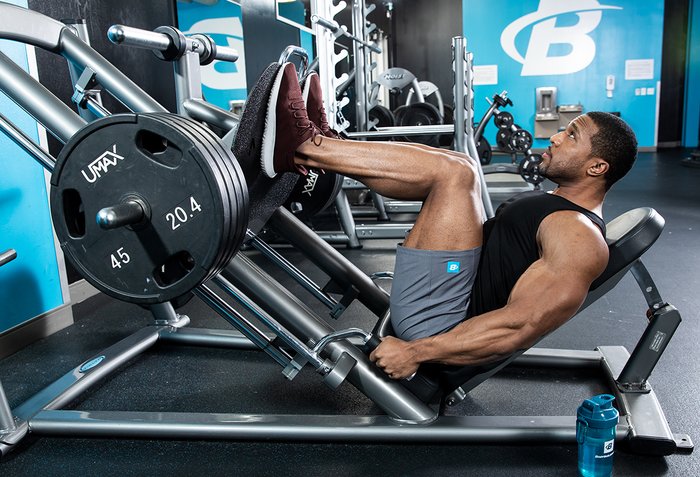Recently decide to get fit? Want to take up a strength or weightlifting program, but don't know where to start? Everyone has been in this position at least once before; you're new at the gym, and you don't know where to go or what to lift or how to use the machines. Well, help is here!
I am going to tell you the basic guidelines and rules for starting out in a weightlifting program; whether it is for strength, weight loss, lean muscle gain, or just overall fitness, this article and workout can help you figure things out and get started off on the right foot toward your health and fitness goals.
Strength training provides remarkable results in those who have tried and failed at overhauling their fitness with just diet or cardio. Consistent training (more than twice per week, for 12 weeks) can provide such benefits as:
- Increased muscle-fiber size
- Increased muscle contractile strength
- Increased tendon strength
- Increased ligament strength
All of these add up to a much healthier, fitter body that is less likely to be injured. You end up looking pretty good, too!

"Strength training provides remarkable results in those who have tried and failed at overhauling their fitness with just diet or cardio."
"Strength training provides remarkable results in those who have tried and failed at overhauling their fitness with just diet or cardio."
A Few Rules Of Lifting Etiquette
- To start, always bring a towel and be kind enough to wipe off the machines, benches and equipment you use.
- Be sure to rerack all the weight and replace all the dumbbells or barbells that are used.
- Don't rest for extended periods of time on a machine that someone is waiting for; if possible, work in with them between sets. Most people are more than willing to share when asked nicely.
- Finally, please leave your cell phone in your locker or car; nothing is more distracting than listening to another person's conversation unwillingly.

Common Mistakes To Avoid
- Using too much weight, too soon; always start lower than your expected ability and work your way up that first workout. If your form suffers, you are swinging the weight, or using momentum, this indicates you may be using too much weight. Greater momentum increases the potential for injury and reduces the effectiveness to the muscle group being targeted.
- Not using enough weight; always play it safe, but if you can perform 30 reps with a certain weight, it's likely time to increase it a bit. Tip: Increase the weight no more than about 5% at a time.
- Moving through repetitions too quickly, going too fast; there is nothing gained by lifting weights fast. Some of the perks of lifting weight in a slow and controlled manner, include more total muscle tension and force produced, more muscle-fiber activation both slow and fast twitch fibers, and less tissue trauma. Remember, a joint is only as strong as the muscles that cross it; if you haven't lifted in a long time, or ever, be careful what you ask of your joints.
- Not resting long enough, or resting far too long; both can be a workout killer. Tip: The recommended rest period is between 30-90 seconds, for overall fitness.
Beginner Weight/Strength Training Workout
Guidelines For This Workout
This workout is designed for overall health and fitness gains of a healthy, adult individual who has never lifted weights before, or who is very inexperienced at it.
You may note that the majority of exercises are machine based; this is intentional as an unconditioned beginner, has less integrity in the joints, less stability in the core which supports the entire body during training; and this makes one more apt to be injured when attempting to lift free weight (dumbbells, barbells) when just starting out.
Using machines provides support for these weaker areas and allows the intended muscle to be isolated and strengthened before progressing to free weight.
- Perform this workout at least two times per week, significant strength and fitness gains are obtained with only two workouts per week.
- Take one day off from weight training between each workout.
- For health gains, at least one set of 8-12 repetitions should be performed to fatigue; this means a weight heavy enough to tire the muscle significantly in 8-12 reps.
- For fitness gains, two sets of 8-12 repetitions should be performed to fatigue; again with a weight heavy enough that the muscle is tired and unable to continue without a 30-90 second rest period.
- It should take four to five seconds to complete one repetition through a complete range of motion; in a slow and very controlled manner.
- Rest at least 30 seconds and no more than 90 seconds between sets of each exercise; and 1 to 2 minutes between each exercise.
Training Tips
A few tips to make your new training program work for you more effectively:
- Stay hydrated! Be sure to drink at least the minimum USDA recommended 8-10 glasses of water each and every day; dehydration can make you weak, and sick and less effective in the weight room. Drink a lot of water during your workout as well.

Stay hydrated!
- Eat a small, balanced meal with equal portions of lean protein (lean chicken, turkey, beef or fish) and complex carbohydrate (oats, rice) 30-60 minutes prior to each workout; and again within 60 minutes after you train with weights. A huge meal is not necessary, just enough protein and carbohydrate to refuel and encourage healing in the body.
- If also performing cardio work for weight loss, do so after you train with weights, not before; or at separate times of the day all together.
- Keep a record of what you do, and when you do it. All you have to do is register for your very own FREE BodySpace profile... You can check that out and register here.
- Also, once you are on your way to being super fit, you can also take progress pictures, keep track of weight loss or gain progress, and measurements of all your body parts. This tool is also part of your free BodySpace profile, there is so much you can track and record.
- Be sure to check out all the aspects of BodySpace while you record and update your daily workouts, and don't forget to stay fit!


